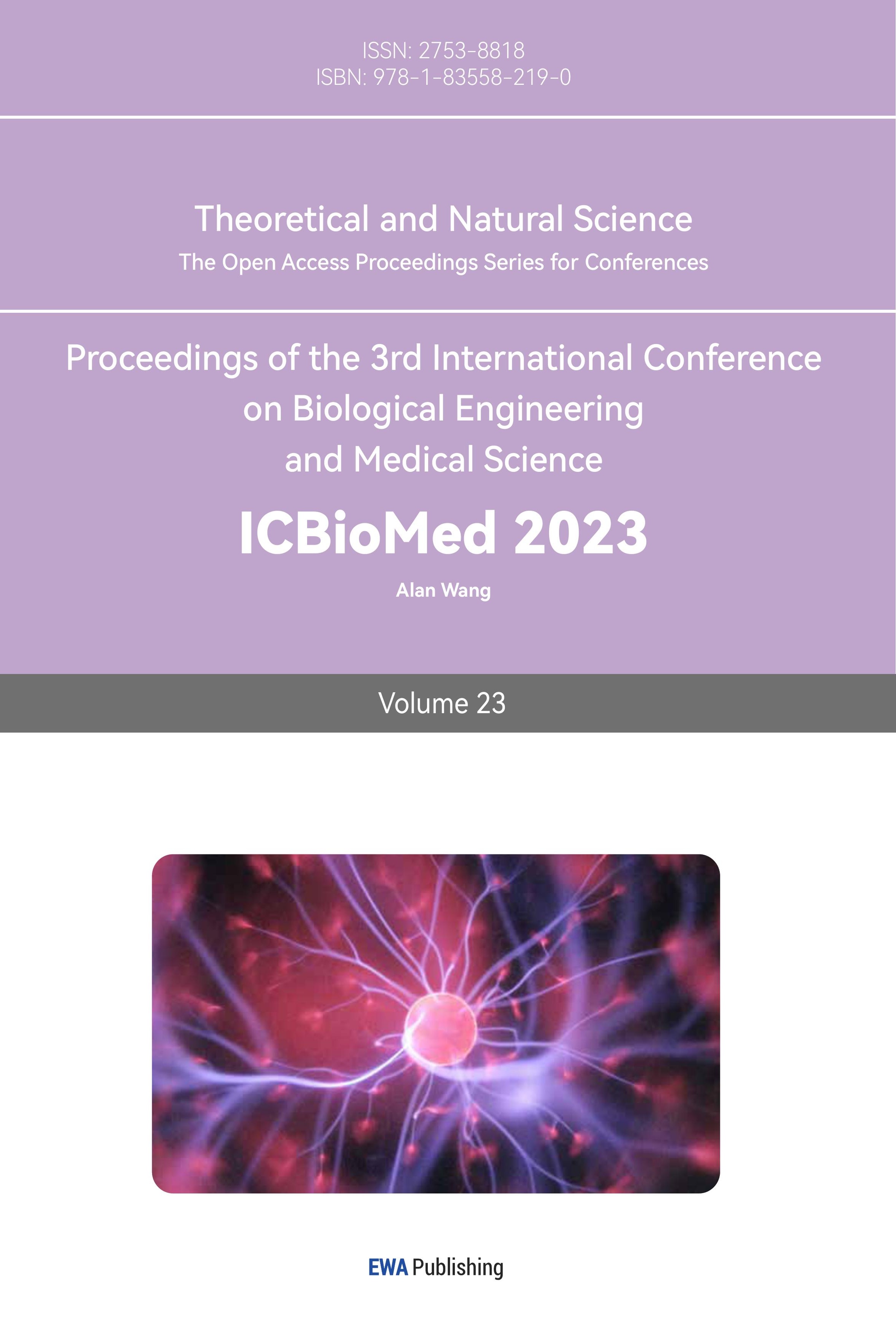References
[1]. Andalibi, M. R., Wokaun, A., Bowen, P. and Testino, A., “Kinetics and mechanism of metal nanoparticle growth via optical extinction spectroscopy and computational modeling: The curious case of colloidal gold,” ACS Nano 13(10), 11510-11521 (2019).
[2]. Patil, T., Gambhir, R., Vibhute, A. and Tiwari, A. P., “Gold Nanoparticles: Synthesis Methods, Functionalization and Biological Applications,” Journal of Cluster Science 34(2), 705-725 (2023).
[3]. Oliver, C., [Preparation of Colloidal Gold], Methods in Molecular Biology, Humana Press, New York & Boston, 363-367 (2010).
[4]. Yamaguchi, K. and Asakawa, H., “Preparation of colloidal gold for staining proteins electrotransferred onto nitrocellulose membranes,” Analytical Biochemistry 172(1), 104-107 (1988).
[5]. Shah, M., Badwaik, V., Kherde, Y., et al., “Gold nanoparticles: various methods of synthesis and antibacterial applications,” Frontiers in Bioscience (Landmark edition) 19(8), 1320-1344 (2014).
[6]. Zhang, Y., Abidi, W. and Berlin, J. M., “Colloidal Capsules Assembled from Gold Nanoparticles Using Small-Molecule Hydrophobic Cross-linkers,” Langmuir : the ACS journal of surfaces and colloids 35(52), 17037-17045 (2019).
[7]. Li, G., Wang, A., Chen, Y., et al., “Development of a colloidal gold-based immunochromatographic strip for rapid detection of severe acute respiratory syndrome coronavirus 2 spike protein,” Front Immunol. 12:635677 (2021).
[8]. Huang, C., Wen, T., Shi, F. J., et al., “Rapid Detection of IgM Antibodies against the SARS-CoV-2 Virus via Colloidal Gold Nanoparticle-Based Lateral-Flow Assay,” ACS Omega 5(21), 12550-12556 (2020).
[9]. Wang, D., Zhang, Z., Li, P., et al., “Time-Resolved Fluorescent Immunochromatography of Aflatoxin B1 in Soybean Sauce: A Rapid and Sensitive Quantitative Analysis,” Sensors (Basel, Switzerland) 16(7), E1094 (2016).
[10]. Wu, Y., Wu, M., Liu, C., et al., “Colloidal gold immunochromatographic test strips for broad-spectrum detection of Salmonella,” Food Control 126:108052 (2021).
[11]. Jennings, T. and Strouse, G., [Past, Present, and Future of Gold Nanoparticles], Nanoparticles: From Theory to Application, Wiley-VCH, Weinheim & Berlin, 81-120 (2004).
[12]. Saha, K., Agasti, S.S., Kim, C., t al., “Gold nanoparticles in chemical and biological sensing,” Chem. Rev. 112(5), 2739-2779 (2012).
[13]. Liu, Y. and Lu, Y., “Biosensing based on nanomaterials: a review,” Nanoscale Res. Lett. 14:100 (2019).
Cite this article
Zhong,Z. (2023). Research progress of colloidal gold technology. Theoretical and Natural Science,23,204-209.
Data availability
The datasets used and/or analyzed during the current study will be available from the authors upon reasonable request.
Disclaimer/Publisher's Note
The statements, opinions and data contained in all publications are solely those of the individual author(s) and contributor(s) and not of EWA Publishing and/or the editor(s). EWA Publishing and/or the editor(s) disclaim responsibility for any injury to people or property resulting from any ideas, methods, instructions or products referred to in the content.
About volume
Volume title: Proceedings of the 3rd International Conference on Biological Engineering and Medical Science
© 2024 by the author(s). Licensee EWA Publishing, Oxford, UK. This article is an open access article distributed under the terms and
conditions of the Creative Commons Attribution (CC BY) license. Authors who
publish this series agree to the following terms:
1. Authors retain copyright and grant the series right of first publication with the work simultaneously licensed under a Creative Commons
Attribution License that allows others to share the work with an acknowledgment of the work's authorship and initial publication in this
series.
2. Authors are able to enter into separate, additional contractual arrangements for the non-exclusive distribution of the series's published
version of the work (e.g., post it to an institutional repository or publish it in a book), with an acknowledgment of its initial
publication in this series.
3. Authors are permitted and encouraged to post their work online (e.g., in institutional repositories or on their website) prior to and
during the submission process, as it can lead to productive exchanges, as well as earlier and greater citation of published work (See
Open access policy for details).
References
[1]. Andalibi, M. R., Wokaun, A., Bowen, P. and Testino, A., “Kinetics and mechanism of metal nanoparticle growth via optical extinction spectroscopy and computational modeling: The curious case of colloidal gold,” ACS Nano 13(10), 11510-11521 (2019).
[2]. Patil, T., Gambhir, R., Vibhute, A. and Tiwari, A. P., “Gold Nanoparticles: Synthesis Methods, Functionalization and Biological Applications,” Journal of Cluster Science 34(2), 705-725 (2023).
[3]. Oliver, C., [Preparation of Colloidal Gold], Methods in Molecular Biology, Humana Press, New York & Boston, 363-367 (2010).
[4]. Yamaguchi, K. and Asakawa, H., “Preparation of colloidal gold for staining proteins electrotransferred onto nitrocellulose membranes,” Analytical Biochemistry 172(1), 104-107 (1988).
[5]. Shah, M., Badwaik, V., Kherde, Y., et al., “Gold nanoparticles: various methods of synthesis and antibacterial applications,” Frontiers in Bioscience (Landmark edition) 19(8), 1320-1344 (2014).
[6]. Zhang, Y., Abidi, W. and Berlin, J. M., “Colloidal Capsules Assembled from Gold Nanoparticles Using Small-Molecule Hydrophobic Cross-linkers,” Langmuir : the ACS journal of surfaces and colloids 35(52), 17037-17045 (2019).
[7]. Li, G., Wang, A., Chen, Y., et al., “Development of a colloidal gold-based immunochromatographic strip for rapid detection of severe acute respiratory syndrome coronavirus 2 spike protein,” Front Immunol. 12:635677 (2021).
[8]. Huang, C., Wen, T., Shi, F. J., et al., “Rapid Detection of IgM Antibodies against the SARS-CoV-2 Virus via Colloidal Gold Nanoparticle-Based Lateral-Flow Assay,” ACS Omega 5(21), 12550-12556 (2020).
[9]. Wang, D., Zhang, Z., Li, P., et al., “Time-Resolved Fluorescent Immunochromatography of Aflatoxin B1 in Soybean Sauce: A Rapid and Sensitive Quantitative Analysis,” Sensors (Basel, Switzerland) 16(7), E1094 (2016).
[10]. Wu, Y., Wu, M., Liu, C., et al., “Colloidal gold immunochromatographic test strips for broad-spectrum detection of Salmonella,” Food Control 126:108052 (2021).
[11]. Jennings, T. and Strouse, G., [Past, Present, and Future of Gold Nanoparticles], Nanoparticles: From Theory to Application, Wiley-VCH, Weinheim & Berlin, 81-120 (2004).
[12]. Saha, K., Agasti, S.S., Kim, C., t al., “Gold nanoparticles in chemical and biological sensing,” Chem. Rev. 112(5), 2739-2779 (2012).
[13]. Liu, Y. and Lu, Y., “Biosensing based on nanomaterials: a review,” Nanoscale Res. Lett. 14:100 (2019).









